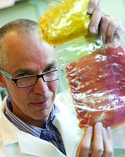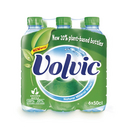Lightening the burden on nature
3 February 2011In the first of our 2011 series of special features on packaging and the environment, the spotlight falls on latest ‘lower impact’ materials and the processes that are producing them. Joanne Hunter Reports.
The move to lighten the burden of packaging on the environment is the driving force behind developments in production processes, product choice and waste streams. Numerous and varied strategies include the use of renewable, recyclable or recycled content; products and systems that exclude potentially toxic materials; using renewable sources for energy; and innovations that give savings in raw material, energy and water use. Packaging can also be tagged ‘green’ because it is space efficient and reduces transport energy use, or it uses intelligent technology to cut down food waste.
Initiatives by leading packaged goods producers can only increase pressure on packaging suppliers to continue to improve the green qualities of their products and systems. Momentum is coming from the food and beverage category, led by Coca-Cola, PepsiCo, Unilever and Danone. But the consumer electronics industry is also doing its bit to satisfy hopes for, and expectations of, more environmentally aware packaging.
Dell’s plan for packaging improvement boils down to a core strategy known as the ‘3 Cs’, which stand for cube, content and curb, and relate respectively to the size of a package, what material is used and its suitability for recycling. It led to an award-winning breakthrough: protective packaging made from China’s native bamboo and converted in China, which ensures Dell consumer electronics produced in China are transported safely to America.
Bamboo packaging is a local solution for China, where commercial quantities are being sustainably grown to FSC certification standards. Bamboo self-propagates, and the next crop is ready to harvest in three to five years. Certified compostable to the American standard (ASTM) D-6400, bamboo packaging can be blended into the OCC (old corrugated cardboard) stream in America without detriment, according to Dell’s converting partner Georgia Pacific. Moreover, due to the bamboo’s characteristic long fibre, it could produce an even stronger recycled product, Oliver Campbell, Dell’s Senior Manager of Packaging Worldwide, tells Packaging Today.
He adds: “Developing packaging that is lightweight, strong enough to protect our products in transit, avoids the need to cut down hardwood trees and can return to the ground to sustain new plant growth – those are the kinds of long-term, sustainable solutions we want to provide for our customers. We’re exploring the frontier of sustainable packaging, and we’re working to integrate more innovative, agricultural materials into our packaging portfolio.”
Procter & Gamble is introducing personal care products in packaging made with sugarcane-derived plastics. Selected products in the Pantene Pro-V, Covergirl and Max Factor ranges are due on the market in 2011.
The supplier, Braskem, manufactures the material using ethanol made from sustainably-grown Brazilian sugarcane, to produce high-density polyethylene (HDPE) plastics. This is said to remain 100% recyclable in existing municipal recycling facilities.
Pressure for change is said to be coming from ‘women around the world’. “They tell us they want to make themselves more beautiful without making their environment less beautiful,'' says Gina Drosos, Group President, Global P&G Beauty.
Volvic Natural Mineral Water’s Greener Bottle is made partially from sugarcane waste and now on shelf in France, Germany and the UK.
Volvic says the new technology achieves a 100% recyclable PET plastics using a renewable plant material. BioPET contains 20% plant material, to reduce the amount of non-renewable material needed to create the bottle. BioPET is created by combining PET with fermented and dehydrated sugarcane waste, a by-product of sugar production. Volvic claims the new bottle has a 38% lower packaging carbon footprint and a 16% lower total life-cycle footprint than the old 50cl bottle. It incorporates 25% recycled plastics from previously used bottles. The weight of the new bottle is down from 17g to 15g.
This is ‘a key milestone’ in Volvic’s effort to reduce the brand’s global carbon footprint by 40% from 2008 to 2012, says Stéphane Cousté, Director, Nature Committee, Evian Volvic Worldwide.
Food packaging is the target use for a compostable sugar-based polymer developed at Imperial College London, UK. The degradable polymer is made from sugars known as lignocellulosic biomass, which come from non-food crops such as fast-growing trees and grasses, or renewable biomass from agricultural or food waste, and so is economical to produce.
The search for greener plastics, especially for single use items such as food packaging, is being spurred on not only from an environmental perspective, but also for economic and supply reasons, explains project team leader Dr Charlotte Williams: “Our key breakthrough was in finding a way of using a non-food crop for a polymer, as there are ethical issues around using food sources in this way.” Ability to manufacture in large volumes was the technical challenge. “It took three and a half years for us to hit a yield of around 80% in a low energy, low water use process,” says Dr Williams.
In the USA, growth in green packaging demand is expected to be relatively modest, at 3.9%/year up to 2014. The mature paperboard and metal packaging sectors already achieve high rates for collection and recycled content, according to a report by Freedonia Group. Degradable packaging will see the fastest gains from a very low base, along with recycled plastics, promoted by price competitiveness with conventional resins, expanding capacities and rising demand for ecological alternatives.
Novamont, the Italian maker of Mater-Bi, partnered Iggesund to produce Invercote Bio, a board coated with a biodegradable bioplastics barrier, paving the way for an established paperboard brand to enter the food and beverages market. Iggesund says it chose Novamont because it could guarantee the material is free from starch from genetically modified plants.
“The base board and the barrier material should live up to the same quality demand in terms of resource, energy and environmental strategies,” says Jonas Adler, Commercial Manager of Iggesund’s value-added products. He concedes that customers have to pay a premium for Invercote Bio over a traditional polyethylene coated product, but says it will help ‘rationalise’ waste management at mass catering events, and similarly benefit high street cafés and bars and reduce their costs.
Huhtamaki offers future-friendly packaging that uses different compostable raw materials, mainly bio-coated paper board, biopolymers and moulded fibre made from recycled paper and paperboard. It uses PLA from NatureWorks.
All its BioWare products are certified in accordance with EN13432, the European norm for compostability of packaging. When disposed of in the optimal conditions (60°C, 95% humidity) of industrial composting facilities, these products will compost into soil in 45-60 days, the company claims.
The BioWare paper cup range is said to be ‘the first complete bio-coated paper hot and cold cup range launched in Europe’.
Greener processes
Packaging materials specialist BoYuan, based in China, is promoting its ability to produce direct metallised paper and paperboard for designing products that are recyclable through a paper mill, biodegradable, and based on substrate from certified sources. The process is targeting carton and pack construction and labelling, and it can be suitable for food applications, adds the company.
John Edwards, BoYuan’s Director of Sales, responsible for business outside of China, mainly in Europe, tells Packaging Today: “By direct metallising with the very latest technology, the process uses 250 times less aluminium than the equivalent foil laminated process as well as providing some unique finishes. “The very latest coating technology is employed utilising less energy and EB (electron beam) technology for curing. This enables 100% solids to be used for coating, taking away the need for solvents and eliminating VOCs (volatile organic compounds). The curing does not use heat, so there are no harmful emissions from the process. So not only is the product ‘green’, so is the process.”
Pregis Rigid Packaging says it is using homogenised rPET in an increasing number of product lines and working with retailers including Marks & Spencer on environmentally responsible developments. This has involved spending £5 million on state-of-the-art thermoforming and extrusion equipment. For example, Vacurema technology allows post-consumer PET waste to be cleaned in-line to food quality standards and meet the Marks & Spencer definition of ‘SuperClean’. The investment will increase rPET capacity at the two Pregis manufacturing plants in England and Scotland.
Using a minimum of 50% post consumer recyclate, Pregis meets the approved rPET requirements for direct food contact, the company states. In food packaging rPET offers a gas barrier for increased shelf life, clarity, strength and rigidity, and it can itself be recycled through approved material recovery facilities.
AWS Eco Plastics’ new plastics bottle sorting facility in the UK can process more than 100,000 tonnes of waste plastics or 2 billion bottles a year, which, the company claims, makes the Hemswell factory ‘the largest and most sophisticated in Europe’. Its capacity is hoped to reach 140,000 tonnes by mid 2011, and by year’s end, Hemswell could be responsible for almost 50% of the UK’s projected recycled total of 300,000 tonnes of plastics bottles/year.
The plant uses equipment by Stadler, Titech and Herbold to process diverse feedstocks. Seventeen polymer and optical sorters are said to give an output of 11 different streams of plastics and ‘virtually zero waste’.
Titech sensor-based systems sort the bottles by polymer type and colour to deliver the purity and consistency of plastics required for food grade pellet.
“There is huge potential in the UK market and this can only grow as the demand for low-carbon food and drink packaging increases,” says Jonathan Short, Managing Director of AWS. “This is a growth industry in which the UK has the potential to be a world-leader, a prime example of the Government’s low-carbon economy.”
Music to the ears of environmentalists is the rising demand from the multimedia products sector for certified material in printed packaging Clear Sound & Vision (CSV), a project management company based in London, UK, says it was behind the first record sleeve to be produced on PEFC certified paper last year, for Brownswood Recordings’ Havana Cultura Remixed.
“It appears to us that the music and media industries are and have been slow on the uptake with FSC & PEFC. Our aim is to change that,” says CSV’s Managing Director, Clive Robins.
The firm specialises in manufacturing CDs, CD ROMs, DVDs, vinyl pressings and associated print, packaging and design. In 2010, it achieved dual PEFC/FSC chain of custody certification, the process by which wood-based products can be traced back to responsibly managed forests.
If it is still considered to be the case that the customer is ‘always right’, then the findings of a 2010 packaging survey are illuminating. Consumers are interested in the origins of their food packaging, with a strong preference for local sourcing, according to UK producer of plastics containers Sharpak. Also, the majority (82%) of respondents wanted retailers to display the origin of food packaging as well as the food itself, and 78% were willing to pay extra for locally sourced packaging. Indeed, the issue of who pays the premium to ensure the environment does not pay dearly is no small matter, and one to be left for another day.
Plastics with food freshness indicator
Intelligent plastics packaging able to warn when food is going off is being developed at Strathclyde University in Scotland.
An indicator made of ‘intelligent plastics’, designed to change colour when food is about to lose its freshness, would be used in modified atmosphere packaging.
As an integral part of the packaging, it is a ‘far less expensive’ alternative to inserting labels in a pack, say the researchers.
“We are aiming to eliminate this cost with new plastics for the packaging industry. We also hope it will have a direct and positive impact on the meat and seafood industries,” says project leader Professor Andrew Mills.
A further aim is to increase food safety and help prevent unnecessary food waste.
Striving to be 100 times better
Manufacturer of consumer packaging Chesapeake is aiming to demonstrate leadership in environmental management in an initiative called the ‘Chesapeake 100’.
“We recognise that due to our scale, making even the smallest changes can deliver impressive results,” says Phillip Adams, Director of CSR.
Chesapeake’s 40 operations worldwide have been tasked with new environmental-related initiatives during 2011. This has generated in excess of 100 annual sustainability projects that will help to reduce energy consumption, water and chemical usage, waste and emissions. These initiatives will also help to improve packaging design, supply chain efficiencies, vehicle fill levels and environmental management systems.
A typical example is a move to change the liner material for self-adhesive labels from a glassine backing to PET. This material is recyclable, allowing the liner to be reprocessed into consumer goods including disposable drinks containers, coat hangers and fleece jackets.
A data sheet outlining the background and objectives of the ‘Chesapeake 100’ is available in five languages and a copy can be downloaded from the website.
Oliver Campbell, Dell’s Senior Manager of Packaging Worldwide. Oliver Campbell Volvic Natural Mineral Water’s Greener Bottle is made partially from sugarcane waste. Volvic Food packaging is just one of the potential applications of the compostable sugar-based polymer. Food packaging Chesapeake aims to show leadership in environmental management. Chesapeake Freshness indicator project leader Professor Andrew Mills. Professor Andrew Mills






